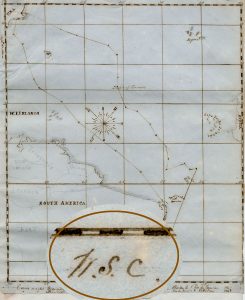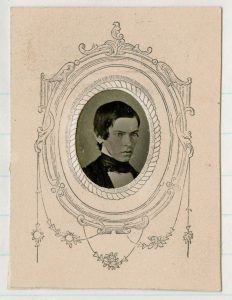by Susan Martin, Processing Archivist & EAD Coordinator
As a processing archivist here at the MHS, I enjoy the opportunity to play detective, to research a newly acquired but unattributed manuscript and try to identify its author. I’ve described some of these “investigations” in previous blog posts: Benjamin Smith, Louisa Appleton, and one of my favorites, Eliza Cheever Davis.
These discoveries are very rewarding. Of course it’s satisfying to solve a mystery, but I also appreciate the chance to uncover some of the fascinating men and women who have been lost to us over time and to ensure they’re part of the historical record.
My mission this time was to identify the author of a journal acquired by the MHS earlier this year. The thin, paper-bound volume, a kind of ship’s log kept from 1847 to 1848, describes a round-trip journey between Boston and Rio de Janeiro on the bark Paulina. Only 34 pages long, the journal includes a lot of detail—not only navigation information, such as latitude, longitude, wind direction, course, etc., but also descriptive entries and some beautiful drawings in the margins.

The journal didn’t come to us as part of a family collection, so I didn’t have the help of context to narrow my search. All I could determine at first was that our author was most likely male, apparently young, and since he wrote about the ship’s captain, mate, and steward…well, he wasn’t one of them. A search for information on the Paulina came up dry, so I went back to the text for clues.
A close reading turned up a few entries containing the letters W.S.C. First this one: “This P.M. painted Fanny’s trunk W.S.C. instead of her initials.” Then two annotations about halfway through the volume, in the same hand but apparently written at later date, followed by “W.S.C.” A map of the Paulina’s route was also signed this way.

These letters were almost certainly the initials of our author. I was getting closer. If nothing else, I could at least include “W.S.C.” in my catalog record for the journal and hope that some intrepid researcher would someday make the identification for us. But I wasn’t giving up yet.
I stumbled on a few other tantalizing details in the text. Someone named Greely saw the ship off when it sailed—a brother or friend, maybe? Fanny, as mentioned above, had been the previous owner of the trunk our young man now used. There was also a reference to a brother Jim.
The author did leave me one very specific biographical tidbit on 15 February 1848: “Birthday – The last of my Teens.” So he was 19 years old, born on 15 February 1829. How to find someone with just their initials, birth date, and a few first names of friends or siblings?
Finally, the coup de grace. When the Paulina returned to Massachusetts, our author wrote, “Mailed letter home – first thing I saw on going ashore was an old paper of Feb 25 saying the T. B. Curtis house 45 Mt Vernon St had caught fire but was ext[inguishe]d with little difficulty.” Could this have been his home? Did the “C” stand for “Curtis”?
A quick online search for “Curtis Boston 1829” (our author’s birth year) didn’t lead me to a genealogical website, as I’d expected, but straight to the guide for one of our very own collections, the Curtis-Stevenson family papers. Listed in the biographical sketches is none other than William Stevenson Curtis, born in 1829!
The other data points lined up. William was the son of James Freeman Curtis and his wife Isabella Pelham (Stevenson) Curtis. William’s seven siblings included brothers James and Greely and a sister Frances, or Fanny. The home on Mount Vernon Street that had caught fire belonged to William’s uncle, Thomas Buckminster Curtis.
All I had to do was head one floor up and check the Curtis-Stevenson family papers to confirm my attribution once and for all and to look for any additional items related to William. I found an amazing family history, written by his sister Isabella. She not only included descriptions of relatives and family anecdotes, but illustrated her volume with photographs, letters, you name it. It was here I got my first glimpse of William Stevenson Curtis, in this small tintype.

Isabella filled in the last few details of William’s story. Willie (as she called him) served as the Paulina’s supercargo, an agent of the ship’s owner responsible for overseeing the loading, unloading, buying, and selling of cargo. An impressive position for someone so young.
Sadly, I learned that William died in May 1849 at the age of 20. He was on another voyage when he died of what Isabella called a “wasting fever” and was buried at sea. His uncle Charles Pelham Curtis wrote to a friend that he had never seen “a more loveable person” and called William’s death a “bolt [that] had been shot” and “a sharp wound” to the family.
Isabella wrote this loving tribute to her brother almost 50 years after his death:
He was the beloved of all, so gentle & just, so helpful and self-sacrificing. He was never robust, having a severe illness in childhood, which left him delicate. This want of health, with its consequent limitations, he bore in the most patient, cheerful way. His young life was made up of acts of thoughtful care for others, and of a most tender devotion to his Mother. “Brother Ibid,” his little sister Mary called him, because he is always the same.
For the catalog record of the William Stevenson Curtis journal, click here.


Congratulations! How many houses on Mt. Vernon Street from Lemuel Shaw’s?